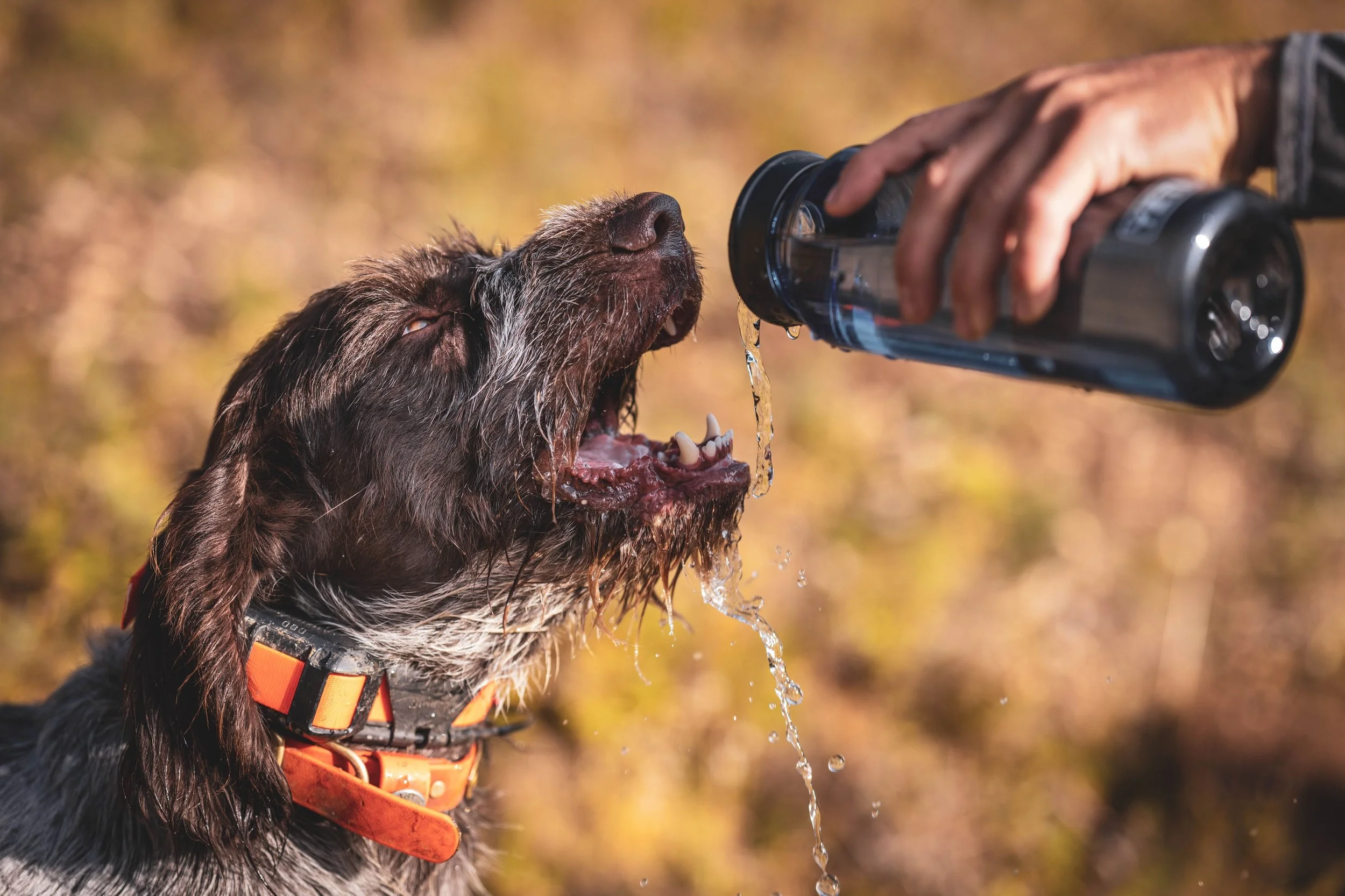What’s the best way to keep your hunting dog hydrated?
Ditch the field bowl. Not only does a squeeze bottle help conserve water, it’s much easier to keep tabs on how much volume your hunting dog has consumed.
With so much discussion about dog food, it’s easy to forget just how important hydration is in the nutrition of canine athletes. Water performs myriad functions in the bodies of performance animals, from lubricating joints to enhancing nutrient uptake in muscles. While dogs can skip many meals without any long-term ill effects, they won’t survive long with a water deficit. Indeed, hydration is a tightly regulated process that every cell in the body depends upon, with very little wiggle room for error.
For this reason, I often field questions from hunting dog owners who express concerns about the volume of water their hunting dogs consume in the field. The good news is most dogs do a great job of regulating their own hydration without any intervention on our behalf. Thirst is a natural response to changes in hydration status. It’s a reflex that dogs involuntarily respond to when the sensation arises, even if that doesn’t coincide with what we think the timeline should be for drinking. Despite our tendency to overanalyze, most thirsty dogs will drink what they need when the urge arises and clean, fresh water is available.
There are, however, a few reluctant or finicky drinkers out there. For the minority of dogs that would rather hunt than drink, you have to get creative in managing their hydration.
Use a squeeze bottle
First, efficient water management starts with water delivery. I strongly recommend that you train your hunting dog to drink from a squeeze bottle rather than a bowl. Not only does this delivery mechanism help conserve water, it’s much easier to keep tabs on how much volume your hunting dog has consumed. If you hunt in western states or other dry conditions, conserving every drop is important, particularly when the burden of carrying it at eight pounds per gallon is literally on your shoulders.
Bait the water
“(Thirst is) a reflex that dogs involuntarily respond to when the sensation arises, even if that doesn’t coincide with what we think the timeline should be for drinking. Despite our tendency to overanalyze, most thirsty dogs will drink what they need when the urge arises and clean, fresh water is available.”
For particularly picky drinkers, it’s acceptable to bait the water with something highly palatable to entice these dogs to drink when they would otherwise decline. I often reach for Forti Flora from Purina as a safe and effective way to enhance the flavor of water. It’s a highly palatable probiotic that’s easy on both the gut and tastebuds without disrupting your dog’s electrolyte balance.
In a pinch, a light dusting of salted beef or chicken broth can be enough to encourage extra water consumption as well. Keep in mind that a light dusting is all that’s required, not a giant serving of salty bouillon in a dog that’s already behind on fluids.
If the dogs and I are drinking from the same squeeze bottle, I will choose something that appeals more to my taste buds than theirs. A light sprinkling of sweetened electrolytes is acceptable in this scenario, as long as you keep in mind that dogs don’t lose electrolytes from physical activity in the same way that we do. Adding back too many electrolytes can contribute to diarrhea in a canine athlete, making a dehydration problem worse.
Float the food
Rehydration can also be achieved quickly and safely at the end of the hunt. Many hunting owners, myself included, employ the tactic of floating their dog’s food during the evening feeding. Simply add fresh water to their food bowl until the dry food is bobbing on top. This technique works well to conserve water in the digestive tract that would otherwise be utilized for rehydrating dry kibble. It also forces dogs to consume the water from the bowl in addition to the kibble they’re craving after a long day in the field.
Assessing hydration in the field
If you’re still convinced that your hunting dog is not keeping up with his water requirements, there are a couple basic ways to easily assess hydration in the field that don’t require a laboratory. An easy and reliable means of checking hydration status is to take note of the frequency of urination and the color of the urine. Well hydrated dogs urinate frequently, and the color is clear to slightly yellow tinged.
The skin pinch test can also be a reliable means of identifying a dehydrated dog. In a dog with adequate hydration, a pinch of skin between your thumb and index finger will quickly return to its normal position. The same tissue in a dehydrated dog will hold its tent or slowly retract. While easy to detect, keep in mind that a dog with a delayed skin pinch is already moderately dehydrated. In these cases, a rehydration plan should have already been implemented before reaching this state. Prevention is far and away the preferred tactic here. Keeping an eye on urine color and urination frequency will help your hunting dog avoid dehydration before it becomes an issue.
Wrapping it up
It’s worth restating that the vast majority of hunting dogs instinctively seek out and consume the proper amount of water given a clean and abundant source along your hunt. Keep track of their consumption and reduce wasted water by using a squeeze bottle, and don’t hesitate to enhance the flavor of the water to encourage finicky dogs to consume a little more. Lastly, consider floating your dog’s post-hunt kibble in half a liter or more of fresh tepid water to safely rehydrate and enhance digestion in your bird dog. With these tips, the only thing they’ll thirst for is another day in the field.


